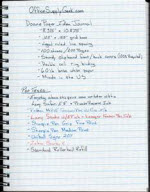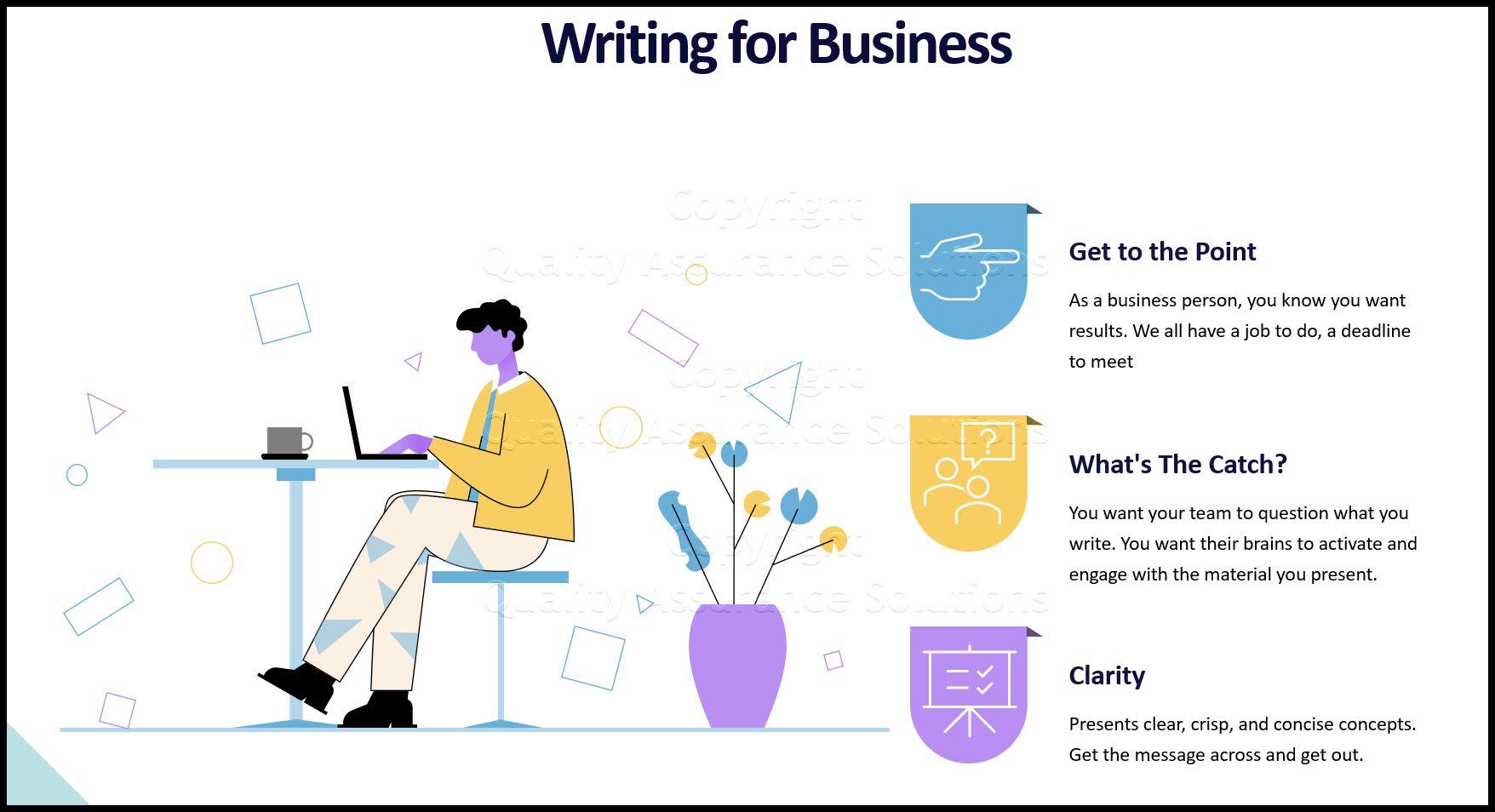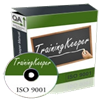Good Business Writing
Good business writing supports every aspect of business, from marketing materials to running effective meetings.
For many the mere thought of writing a letter or memo, soon to be read by your peers, makes your writing hand tremble.
Many professionals develop negative thoughts about their writing skills. Just thinking about filling a blank page can cause 10 acute excuses for writer's block.
Memories of red slashes from college professor's pens, misplaced commas, misspelled words, and dangling participles come flooding back.
Fear not. This skill that can be learned. Hopefully no lives depend on you writing the "great American novel", but you can learn to enjoy the writing process.
"You learn to write by writing."--Samuel Johnson
Business writing does not have to be a chore. It simply means communicating clearly, making your point and getting out. No-one gets hurt.
8D Manager Software with 8D, 9D, 5Y and 4M report generator. Your corrective action software for managing, measuring, and reporting issues.
Here are 3 Tips of Good Business Writing:
1) Help your busy readers. . . get to the point already.
As a business person, you know you want results. We all have a job to do, a deadline to meet. Right?
People want clear, straightforward, and simple communication.
For team communication, you write to a group of individuals who have their own agendas, responsibilities, time constraints, and problems. They also maintain a method of preferred communication.
Focus on your core concept and connect with the people on a personal level.
If you can't meet people in their realm, they'll ignore your attempts at communication.
Make your sentences clear, direct, snappy, and to-the-point.
Present one idea per paragraph, and try to stay on subject. Focus on connecting with your reader's needs. Make sure you know exactly the information you want them to take away from your message.
Your comprehensive package for learning and training the TRIZ problem solving methodology. Includes mobile app, books, PowerPoints and real world examples.
2) What's The Catch? Where are we going? How do we get there?
You want your team to question what you write. You want their brains to activate and engage with the material you present.
Questions are the sign of an engaged reader.
As you draft your business writing, think about how you can engage your team, persuade them to see things from your point of view. Find alignment between the core message of your presentation and the core values of your readers.
Keep your words few, focused, and pushing forward and people will follow.
3) Write for Clarity
Good business writing presents clear, crisp, and concise concepts. After all, you're not Leo Tolstoy. Get the message across and get out.
Structure your writings to get results, to have people take action, or to stop them from doing something.
Tips for Clear Writing:

a) Breathe Deep - Shallow breathing starts your fight or flight mechanism.
A clear message equates to a cool drink of water, or a breath of fresh air. Breathe deep and get some oxygen into your O2 starved brain.
b) Start with the intended result. Make sure you relate the consequences and benefits of your message. Keep the end result or action in your reader minds at all times.
c) Give good business writing the time it deserves. You don't need to polish everything. But give your piece the time it deserves and review it before you send it out. I recommend waiting an hour before your review. This resets your eyes and gives you a fresh perspective. This can prevent embarrassment later.
d) Kill your internal critic. Have you ever sat down to write and you can feel the words in your brain wanting to escape? You know your subject matter, but the words come out like squeezing blood out of your forehead?
"This is your internal critic messing with you, he/she is the scourge of all writers and must be ignored completely at all time" Just write, your secret to good business writing.
TrainingKeeper Software. Keep, organize and plan all your employees' training and activities. Software includes multi-user support with reports, certs, and calendars.
Sentence Structure Tips

Keep your sentences simple. Use the sentence structure of Subject then Verb. To make your sentences pop, avoid the words is, are, have, be, and been. These words bore the reader. When you remove these words, you actually make shorter sentences.
For example above I wrote...
"This is your internal critic messing with you, he/she is the scourge of all writers and must be ignored completely at all time"
Instead, use this better sentence...
"Your internal critic messes with you. You must completely ignore this internal critic scourge at all times. "
Of course you can't always avoid is, are, have, be and been. Just try to minimize the use of these words. When you see them try to restructure your sentence.
Your ISO 9001:2015 Kit includes Templates, QA Manual, Implementation Guide and a Gap Assessment Internal Audit Tool for ISO 9001:2015
Writing for the Web
Readers read the web differently than they do a book. Many web readers first scan the page looking for interesting material. Next they focus on that material.
Web readers don't like long paragraphs. So keep sentences short and few. One to Four sentences work.
Keep paragraphs at different sizes within a topic. Readers treat a webpage like a picture. Text paragraphs form part the web pages. Different size paragraphs attract the reader's eyes to that section. For example, this section has paragraphs with 3 then 2 then 4 then 1 lines.
Also include actual pictures within the web page.
8D Manager Software with 8D, 9D, 5Y and 4M report generator. Your corrective action software for managing, measuring, and reporting issues.
A Tense Situation…
The tense you use in your writing makes a surprising difference with good business writing.
Present tense is so much more active – it breathes life into your sales letter.
Describe something as if your reader is experiencing it right now and it is easier for them to visualise owning whatever it is you are selling; whether a solution to a problem, a service or a product.
So should you always use present tense?
Absolutely not!
Let me explain…
Anything written in future tense is not so vivid; it’s something that may happen – but could just as easily not. And your reader may not see himself in that particular scenario. And there are times when you don’t want him to.
Here’s an example…
You write your letter or advert or web page describing the pain or problem he is experiencing; or the pleasure he is missing. You paint the glowing picture of the relief or joy or satisfaction or status he does have because he took up your offer. That’s how you want him to see himself.
Offer a guarantee and your prospect is ethically persuaded to take your offer; especially if you include a risk-free money-back guarantee. But you do not want your new customer to visualize himself asking for a refund. So for good business writing, you use future tense:
“If you are unhappy, for any reason, all you have to do is ask for a refund and we will give you your money back, no questions asked”.
In this way you are showing that asking for a refund is a possibility – but not a definite.
Get Green Belt Certified with this extensive on-line course. Learn the Six Sigma tools and steps. Earn 25 PMI PDU. Start implementing Six Sigma today
Using Bullets
Want to get your message across to your target audience? Want to get them excited and eager about your product or service? Want to draw them inexorably towards the sale without a moment’s hesitation?
Master good business writing with powerful ‘hit the mark’ bullets and you increase your chances of success ten, even one hundred-fold.
Look at the winning sales websites; those used to launch highly successful products, programs, self-study courses and marketing programs and you’ll see they all have one thing in common – bullet paragraphs drawing a clear picture of what you can expect when you take up the offer; or bullet descriptions of the problems you face to which they have the perfect solution.
Ever found yourself so caught up reading a website or letter you can’t draw away? It’s acted like a magnet to your eyes and senses? Why? What has fired your imagination?
Short, to the point, focused – a rapid-fire – of bullets.
Good business writing includes bullets. They are ideal for catching the skimmers – they are short and succinct. Great for highlighting the key benefits and results the offer is making.
Writing Bullets
You can learn how to write bullets. The easiest way? Write them!
- Find the web or sales letter that grabbed your attention, one that you found hard to resist (or maybe you didn’t; maybe you succumbed!).
- Grab a pen and paper and find somewhere quiet, where you won’t be disturbed.
- Copy the bullets in your own handwriting; absorb the phrasing, the rhythm. Notice the words.
- Repeat the exercise with other letters; just make sure the bullets you copy are vibrant, alive and speak to you.
- Re-write every bullet point again for your own product or service.
Avoid Gobbledygook
Even with good business writing it is very easy to get too enthusiastic with a product or service description – especially when writing about your own business.
How often have you seen a letter or web page that just seems a bit over the top? Outrageous, unbelievable, over-the-top claims throw up barriers, even if the offer is genuine. Even if we are careful about making genuine claims we can sometimes slip into gobbledygook without even realizing it!
So what, exactly, is gobbledygook?
The definition of gobbledygook is: Unclear, often verbose language, usually bureaucratic jargon.
I think there is a bit more to it than that because there is a lot of confusing terminology creeping into our everyday language, jargon that really doesn’t make any sense at all. I often see jargon being used as a way of ‘blinding with science’. Not such good business writing because creating confusion in your prospect’s mind rarely turns them into a customer.
So why am I talking about gobbledygook? Well, after my post about making sure your messages are clear, I was intrigued by a question in an email I received that asked:
“What words make you cringe when you see them in copy?”
I guess we all have our favorite phrases or cliches, even if we avoid using industry jargon, but some of the language we use in our writing can set the BS bells ringing unintentionally and that, of course, can prevent a sale or response.
Think Carefully and Review
Do you use clichés when you’re talking to people? You know, things like ‘he’s as good as gold’?
And do you use them when writing your sales letters? After all, the best sales letter is written in the same way that you’d talk to someone, so you might include a common phrase. If you do, learn from my mistake and think carefully about what you use.
This is what happened. I sent an email to my subscribers to tell them about a blogging program I started off with…
“How do you find time to keep in constant communication with customers and prospects – without tearing your hair out?”
So, what’s wrong with that you might be asking? Or, if you’re like one of my subscribers who replied to my email, you may have spotted my faux pas!
His reply was simply: “I’m bald”
Was my face red!
So, whilst popular phrases can help to bring your letter alive and make it more vibrant, for good business writing, be careful that what you use isn’t alienating part of your audience.
- QAS Home
- Communication
- Good Business Writing
|
Quality Assurance Solutions Robert Broughton (805) 419-3344 USA |
 |
|
Software, Videos, Manuals, On-Line Certifications | ||
|
450+ Editable Slides with support links | ||
|
Corrective Action Software | ||
|
Plan and Track Training | ||
|
AQL Inspection Software |
|
Learn and Train TRIZ | ||
|
Editable Template | ||
|
Templates, Guides, QA Manual, Audit Checklists | ||
|
EMS Manual, Procedures, Forms, Examples, Audits, Videos | ||
|
On-Line Accredited Certifications Six Sigma, Risk Management, SCRUM | ||
|
Software, Videos, Manuals, On-Line Certifications |































